Abstract
1 Acute administration of clonazepam, diazepam, and diphenylhydantoin to mice elevated cerebral 5-hydroxytryptamine (5-HT) and 5-hydroxyindoleacetic acid (5-HIAA); chronic administration had less effect. 2 Acute administration of clonazepam and diazepam but not diphenylhydantoin raised cerebral trytophan levels; chronic administration of clonazepam caused a smaller elevation of cerebral tryptophan but chronic administration of diazepam still caused a large rise in cerebral tryptophan. 3 Neither clonazepam nor diazepam caused induction of drug metabolizing enzymes on chronic administration but diphenylhydantoin had a marked effect. 4 These data suggest that the altered 5-HT metabolism caused by these compounds is unrelated to a common action on tryptophan levels, and that the reduced effect of clonazepam and diazepam on chronic administration cannot be attributed to increased metabolism of these compounds. 5 Clonazepam induced abnormal head movements in mice in a dose-dependent manner. Pretreatment of animals with tranylcypromine increased the intensity of movement, although pargyline was without effect. Similar effects were observed with diazepam and diphenylhydantoin, suggesting that the increase in cerebral 5-HT caused by these compounds is of functional significance in stimulating 5-HT receptors.
Full text
PDF
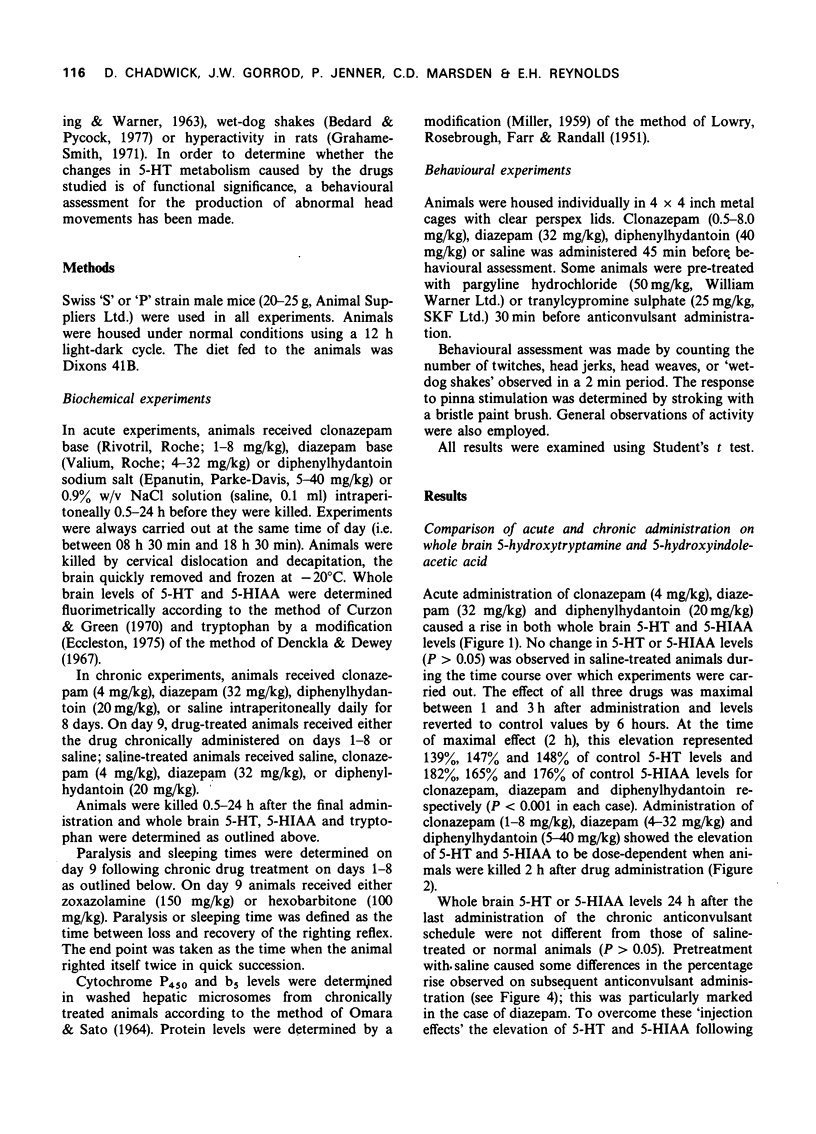
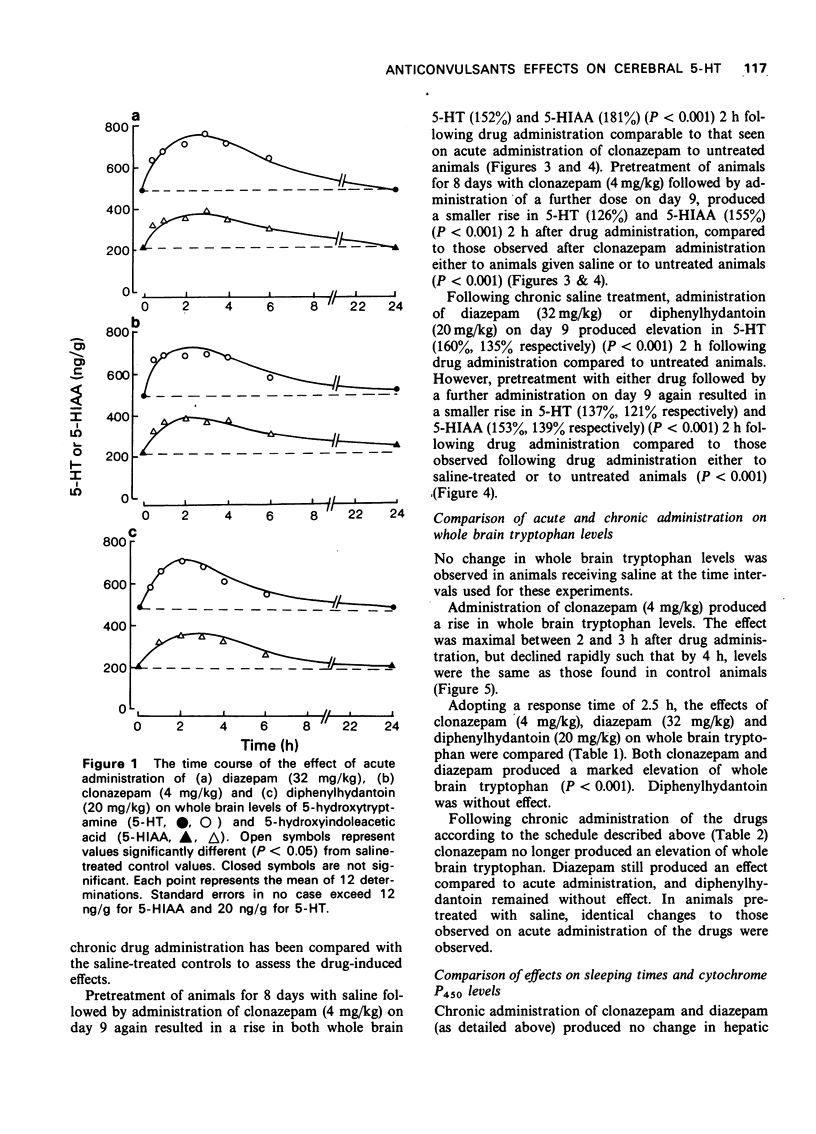
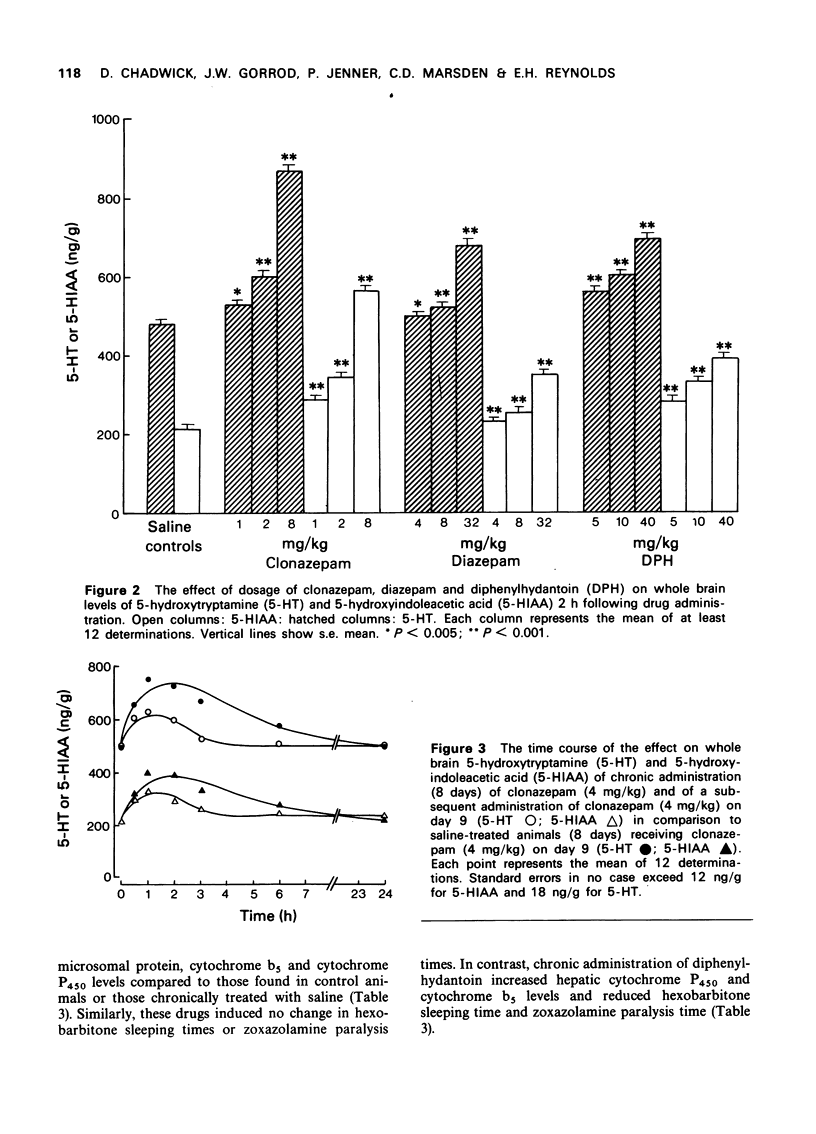
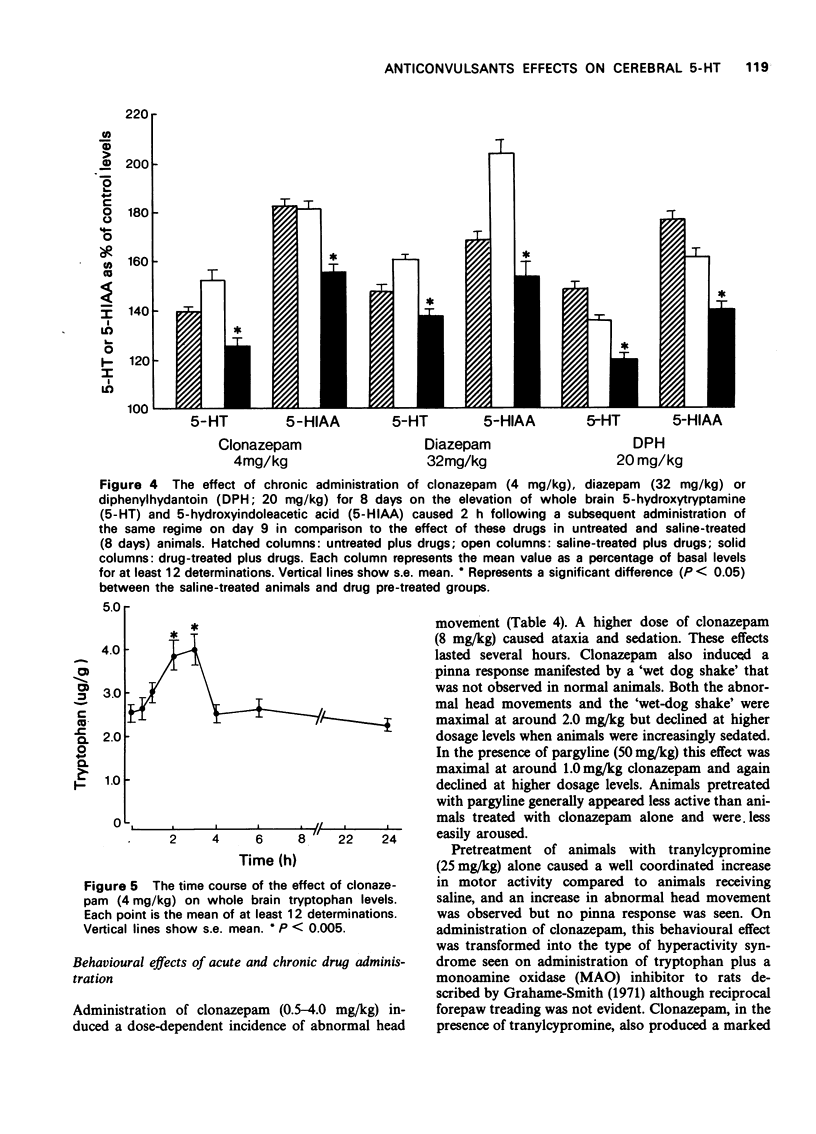
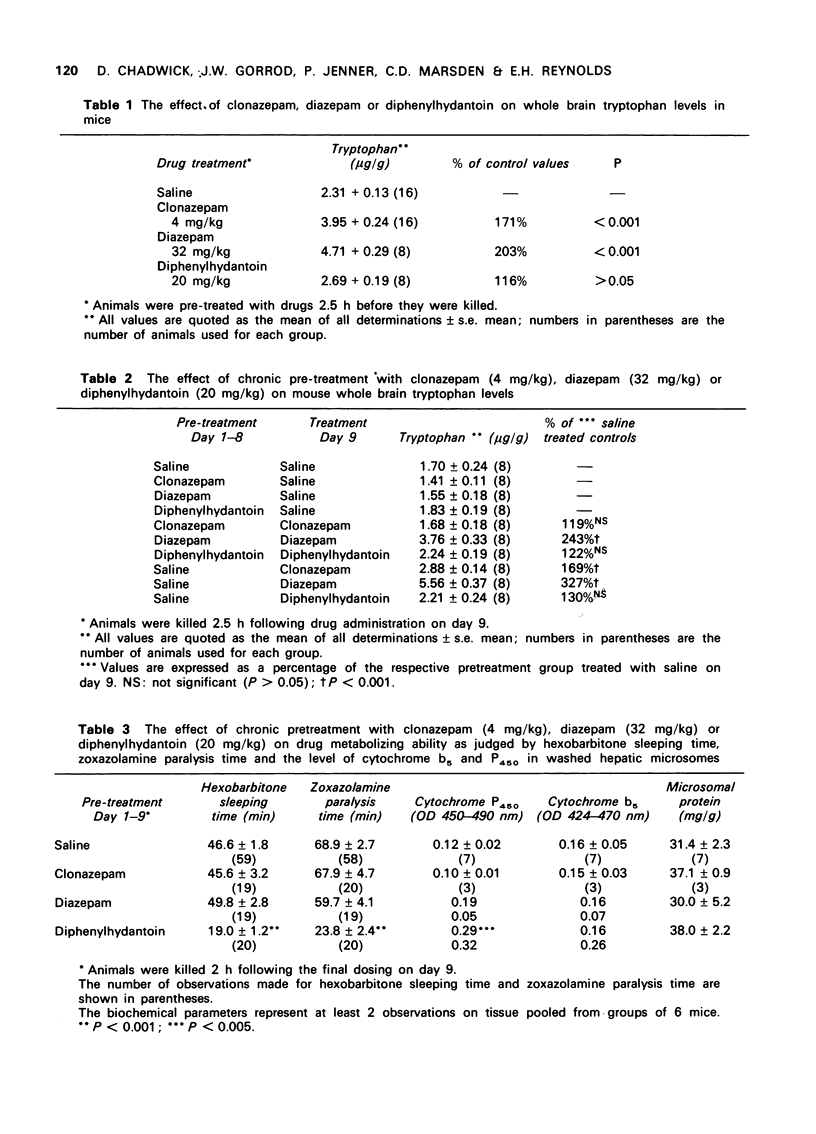
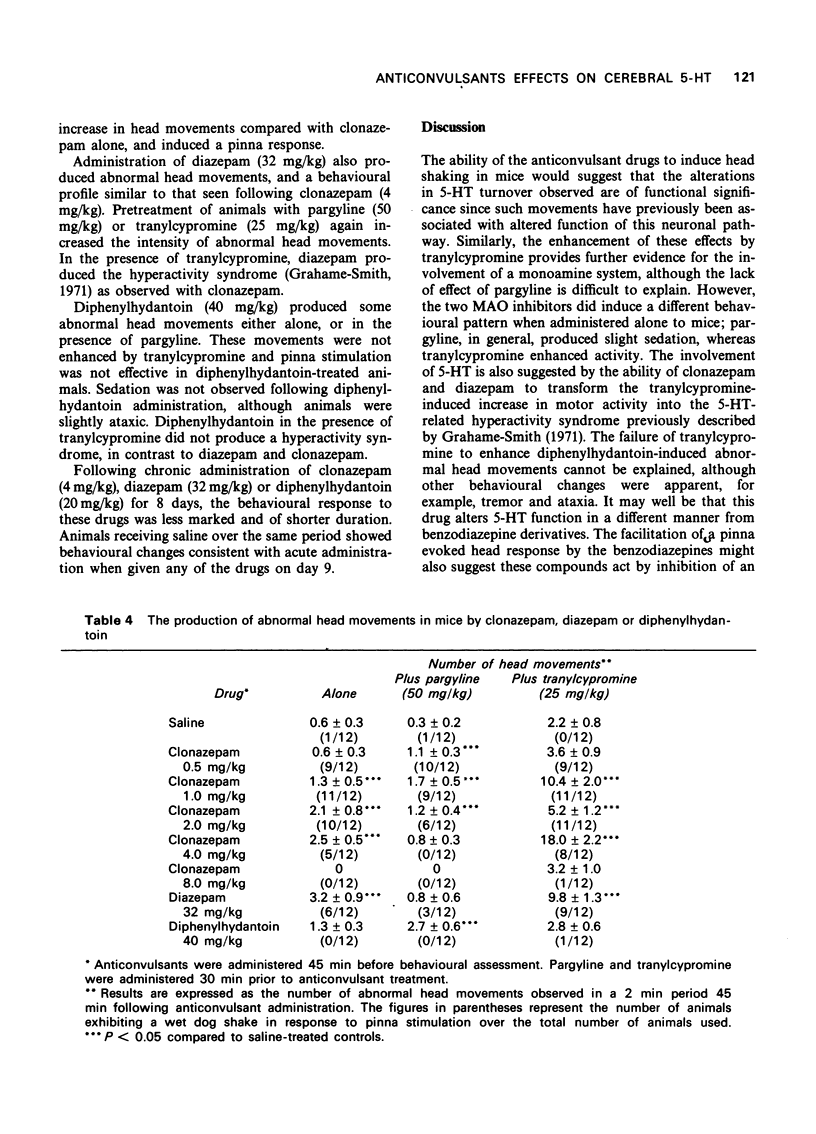
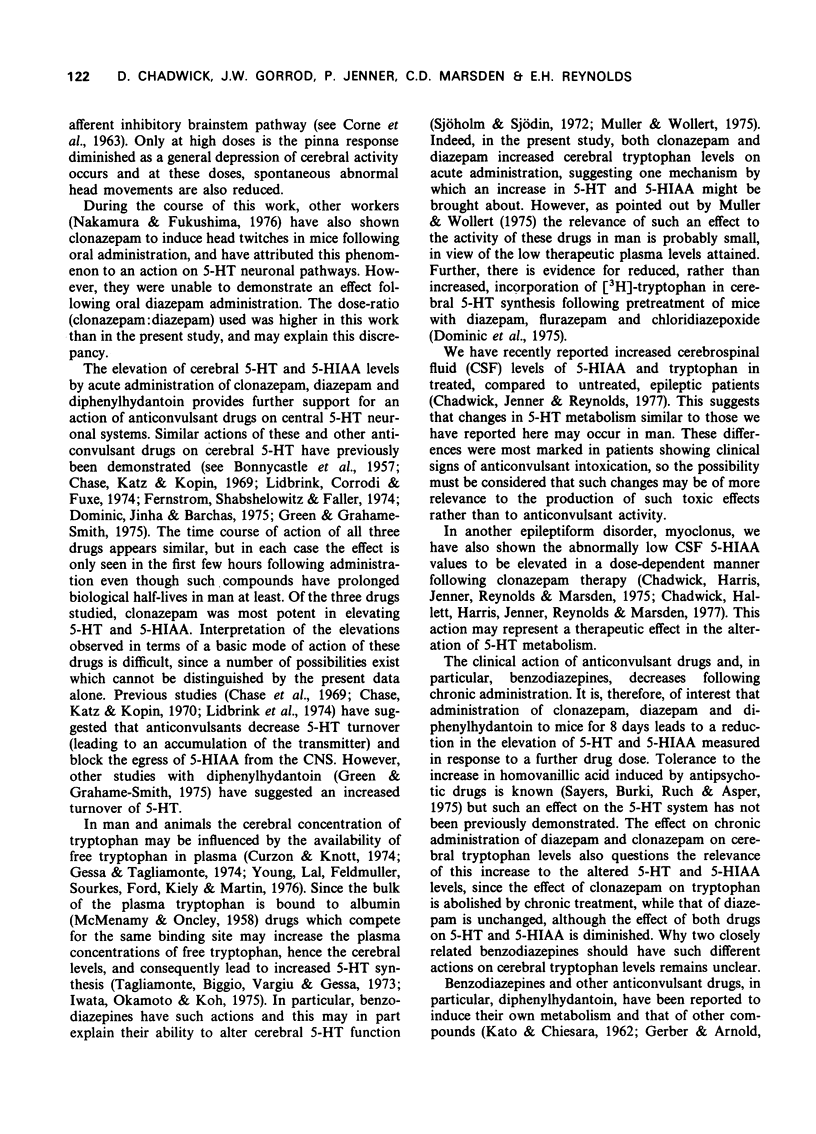
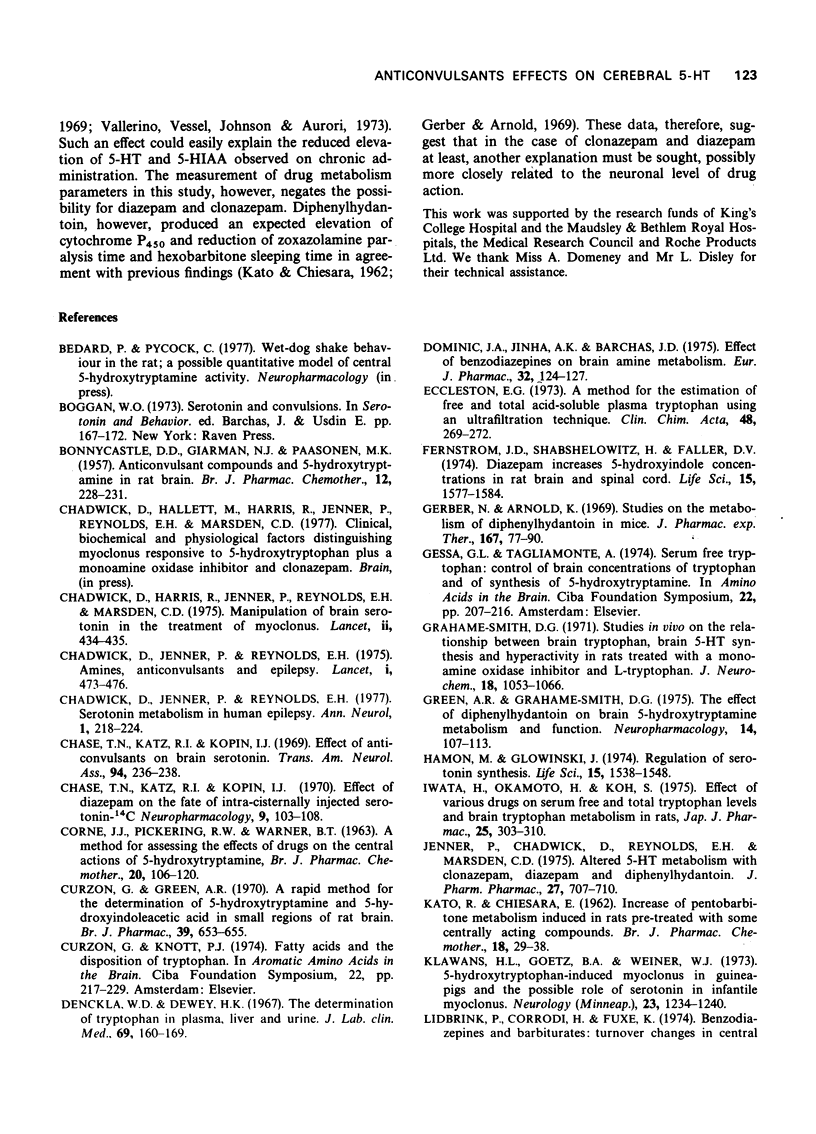
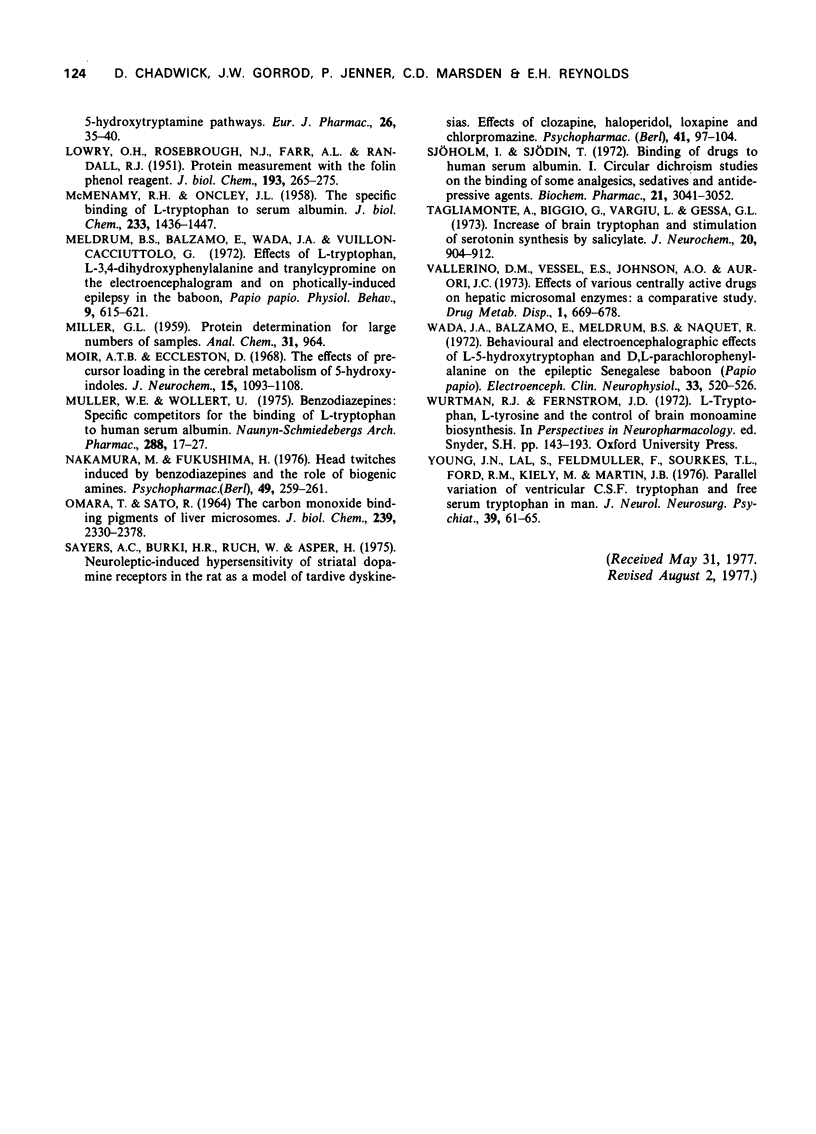
Selected References
These references are in PubMed. This may not be the complete list of references from this article.
- BONNYCASTLE D. D., GIARMAN N. J., PAASONEN M. K. Anticonvulsant compounds and 5-hydroxytryptamine in rat brain. Br J Pharmacol Chemother. 1957 Jun;12(2):228–231. doi: 10.1111/j.1476-5381.1957.tb00125.x. [DOI] [PMC free article] [PubMed] [Google Scholar]
- CORNE S. J., PICKERING R. W., WARNER B. T. A method for assessing the effects of drugs on the central actions of 5-hydroxytryptamine. Br J Pharmacol Chemother. 1963 Feb;20:106–120. doi: 10.1111/j.1476-5381.1963.tb01302.x. [DOI] [PMC free article] [PubMed] [Google Scholar]
- Chadwick D., Jenner P., Harris R., Reynolds E. H., Marsden C. D. Manipulation of brain serotonin in the treatment of myoclonus. Lancet. 1975 Sep 6;2(7932):434–435. doi: 10.1016/s0140-6736(75)90846-6. [DOI] [PubMed] [Google Scholar]
- Chadwick D., Jenner P., Reynolds E. H. Amines, anticonvulsants, and epilepsy. Lancet. 1975 Mar 1;1(7905):473–476. doi: 10.1016/s0140-6736(75)92827-5. [DOI] [PubMed] [Google Scholar]
- Chadwick D., Jenner P., Reynolds E. H. Serotonin metabolism in human epilepsy: the influence of anticonvulsant drugs. Ann Neurol. 1977 Mar;1(3):218–224. doi: 10.1002/ana.410010304. [DOI] [PubMed] [Google Scholar]
- Chase T. N., Katz R. I., Kopin I. J. Effect of anticonvulsants on brain serotonin. Trans Am Neurol Assoc. 1969;94:236–238. [PubMed] [Google Scholar]
- Chase T. N., Katz R. I., Kopin I. J. Effect of diazepam on fate of intracisternally injected serotonin-C14. Neuropharmacology. 1970 Mar;9(2):103–108. doi: 10.1016/0028-3908(70)90053-5. [DOI] [PubMed] [Google Scholar]
- Curzon G., Green A. R. Rapid method for the determination of 5-hydroxytryptamine and 5-hydroxyindoleacetic acid in small regions of rat brain. Br J Pharmacol. 1970 Jul;39(3):653–655. doi: 10.1111/j.1476-5381.1970.tb10373.x. [DOI] [PMC free article] [PubMed] [Google Scholar]
- Denckla W. D., Dewey H. K. The determination of tryptophan in plasma, liver, and urine. J Lab Clin Med. 1967 Jan;69(1):160–169. [PubMed] [Google Scholar]
- Dominic J. A., Sinha A. K., Barchas J. D. Effect of benzodiazepine compounds on brain amine metabolism. Eur J Pharmacol. 1975 May;32(1):124–127. doi: 10.1016/0014-2999(75)90332-5. [DOI] [PubMed] [Google Scholar]
- Eccleston E. G. A method for the estimation of free and total acid-soluble plasma tryptophan using an ultrafiltration technique. Clin Chim Acta. 1973 Oct 30;48(3):269–272. doi: 10.1016/0009-8981(73)90195-2. [DOI] [PubMed] [Google Scholar]
- Fernstrom J. D., Shabshelowitz H., Faller D. V. Diazepam increases 5-hydroxyindole concentrations in rat brain and spinal cord. Life Sci. 1974 Nov 1;15(9):1577–1584. doi: 10.1016/0024-3205(74)90323-3. [DOI] [PubMed] [Google Scholar]
- Gerber N., Arnold K. Studies on the metabolism of diphenylhydantoin in mice. J Pharmacol Exp Ther. 1969 May;167(1):77–90. [PubMed] [Google Scholar]
- Grahame-Smith D. G. Studies in vivo on the relationship between brain tryptophan, brain 5-HT synthesis and hyperactivity in rats treated with a monoamine oxidase inhibitor and L-tryptophan. J Neurochem. 1971 Jun;18(6):1053–1066. doi: 10.1111/j.1471-4159.1971.tb12034.x. [DOI] [PubMed] [Google Scholar]
- Green A. R., Grahame-Smith D. G. The effect of diphenylhydantoin on brain 5-hydroxytryptamine metabolism and function. Neuropharmacology. 1975 Feb;14(2):107–113. doi: 10.1016/0028-3908(75)90033-7. [DOI] [PubMed] [Google Scholar]
- Hamon M., Glowinski J. Regulation of serotonin synthesis. Life Sci. 1974 Nov 1;15(9):1533–1548. doi: 10.1016/0024-3205(74)90320-8. [DOI] [PubMed] [Google Scholar]
- Iwata H., Okamoto H., Ko S. Effects of various drugs on serum free and total tryptophan levels and brain tryptophan metabolism in rats. Jpn J Pharmacol. 1975 Jun;25(3):303–310. doi: 10.1254/jjp.25.303. [DOI] [PubMed] [Google Scholar]
- Jenner P., Chadwick D., Reynolds E. H., Marsden C. D. Altered 5-HT metabolism with clonazepam, diazepam and diphenylhydantoin. J Pharm Pharmacol. 1975 Sep;27(9):707–710. doi: 10.1111/j.2042-7158.1975.tb09539.x. [DOI] [PubMed] [Google Scholar]
- KATO R., CHIESARA E. Increase of pentobarbitone metabolism induced in rats pretreated with some centrally acting compounds. Br J Pharmacol Chemother. 1962 Feb;18:29–38. doi: 10.1111/j.1476-5381.1962.tb01147.x. [DOI] [PMC free article] [PubMed] [Google Scholar]
- Klawans H. L., Jr, Goetz C., Weiner W. J. 5-Hydroxytryptophan-induced myoclonus in guinea pigs and the possible role of serotonin in infantile myoclonus. Neurology. 1973 Nov;23(11):1234–1240. doi: 10.1212/wnl.23.11.1234. [DOI] [PubMed] [Google Scholar]
- LOWRY O. H., ROSEBROUGH N. J., FARR A. L., RANDALL R. J. Protein measurement with the Folin phenol reagent. J Biol Chem. 1951 Nov;193(1):265–275. [PubMed] [Google Scholar]
- Lidbrink P., Corrodi H., Fuxe K. Benzodiazepines and barbiturates: turnover changes in central 5-hydroxytryptamine pathways. Eur J Pharmacol. 1974 Apr;26(1):35–40. doi: 10.1016/0014-2999(74)90071-5. [DOI] [PubMed] [Google Scholar]
- McMENAMY R. H., ONCLEY J. L. The specific binding of L-tryptophan to serum albumin. J Biol Chem. 1958 Dec;233(6):1436–1447. [PubMed] [Google Scholar]
- Meldrum B. S., Balzamo E., Wada J. A., Vuillon-Cacciuttolo G. Effects of L-tryptophan, L-3, 4, dihydroxyphenylalanine and tranylcypromine on the electroencephalogram and on photically induced epilepsy in the baboon, Papio papio. Physiol Behav. 1972 Oct;9(4):615–621. doi: 10.1016/0031-9384(72)90020-0. [DOI] [PubMed] [Google Scholar]
- Moir A. T., Eccleston D. The effects of precursor loading in the cerebral metabolism of 5-hydroxyindoles. J Neurochem. 1968 Oct;15(10):1093–1108. doi: 10.1111/j.1471-4159.1968.tb06827.x. [DOI] [PubMed] [Google Scholar]
- Müller W. E., Wollert U. Benzodiazepines: specific competitors for the binding of L-tryptophan to human serum albumin. Naunyn Schmiedebergs Arch Pharmacol. 1975;288(1):17–27. doi: 10.1007/BF00501811. [DOI] [PubMed] [Google Scholar]
- Nakamura M., Fukushima H. Head twitches induced by benzodiazepines and the role of biogenic amines. Psychopharmacology (Berl) 1976 Sep 29;49(3):259–261. doi: 10.1007/BF00426826. [DOI] [PubMed] [Google Scholar]
- OMURA T., SATO R. THE CARBON MONOXIDE-BINDING PIGMENT OF LIVER MICROSOMES. I. EVIDENCE FOR ITS HEMOPROTEIN NATURE. J Biol Chem. 1964 Jul;239:2370–2378. [PubMed] [Google Scholar]
- Sayers A. C., Bürki H. R., Ruch W., Asper H. Neuroleptic-induced hypersensitivity of striatal dopamine receptors in the rat as a model of tardive dyskinesias. Effects of clozapine, haloperidol, loxapine and chlorpromazine. Psychopharmacologia. 1975;41(2):97–104. doi: 10.1007/BF00421063. [DOI] [PubMed] [Google Scholar]
- Sjöholm I., Sjödin T. Binding of drugs to human serum albumin. I. Circular dichroism studies on the binding of some analgesics, sedatives and anti-depressive agents. Biochem Pharmacol. 1972 Nov 15;21(22):3041–3052. doi: 10.1016/0006-2952(72)90196-7. [DOI] [PubMed] [Google Scholar]
- Tagliamonte A., Biggio G., Vargiu L., Gessa G. L. Increase of brain tryptophan and stimulation of serotonin synthesis by salicylate. J Neurochem. 1973 Mar;20(3):909–912. doi: 10.1111/j.1471-4159.1973.tb00054.x. [DOI] [PubMed] [Google Scholar]
- Wada J. A., Balzamo E., Meldrum B. S., Naquet R. Behavioural and electrographic effects of L-5-hydroxytryptophan and D, L-parachlorophenyl-alanine on epileptic Senegalese baboon (Papio papio). Electroencephalogr Clin Neurophysiol. 1972 Nov;33(5):520–526. doi: 10.1016/0013-4694(72)90216-7. [DOI] [PubMed] [Google Scholar]
- Young S. N., Lal S., Feldmuller F., Sourkes T. L., Ford R. M., Kiely M., Martin J. B. Parallel variation of ventricular CSF tryptophan and free serum tryptophan in man. J Neurol Neurosurg Psychiatry. 1976 Jan;39(1):61–65. doi: 10.1136/jnnp.39.1.61. [DOI] [PMC free article] [PubMed] [Google Scholar]


